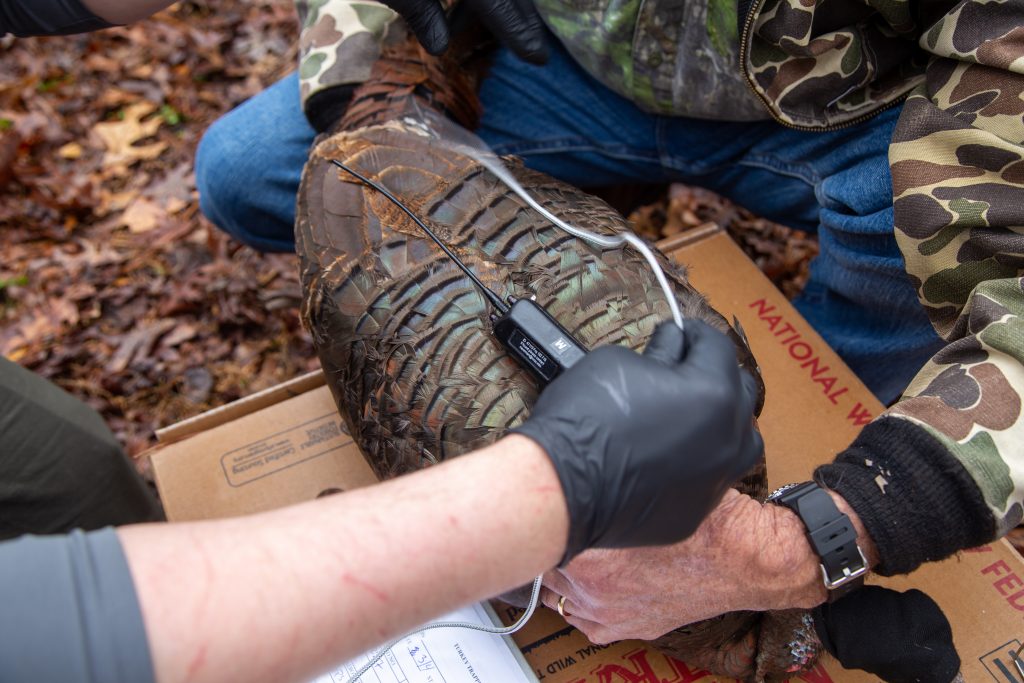The Continuing Evolution of Turkey Knowledge
Tagging wild turkeys with GPS technology has opened the door to a wide range of research possibilities.
Wild turkey capture and tagging operations by college graduate students and state agency wildlife technicians were intense this year,** setting the stage for a deluge of field research efforts over the next several months. Transitioning from the excitement of those operations to the day-to-day grind of field work is an exciting time for me as the professor. It means the data on which management and conservation decisions are made is finally coming into focus.
Collecting data useful to our agency collaborators in directing conservation actions is the most important part of all our research efforts. This had me thinking about how our wild turkey knowledge has changed during my professional career and how much we’ve been able to increase the level of detail in the data we collect.
Here is my look at how wild turkey data collection has evolved and how that impacts wild turkey management.
Technology in Our Corner
Waxing nostalgic, I remember being at a wildlife conference and sitting in a bar in California with a friend in the telemetry industry. He was showing me a small GPS unit his company had built for attaching to a seal’s head. I asked, “Why couldn’t we put that on a turkey?” We proceeded to draw the original turkey GPS unit on a bar napkin. He took that drawing, built me a prototype and that, as they say, was the ball game. The arrival of GPS technology for wild turkeys has driven research for the last decade, opening the field of wild turkey biology up to new and exciting questions.
Technology Changing Science?
In the old days — think late ‘90s and early 2000s — if we wanted to measure vegetation or insect abundance at places where wild turkey females guided poults for foraging, we would have to track (using telemetry) in on them to collect our samples. Turkeys, though, generally don’t let people get near them. We couldn’t guarantee that where we found the hen was where the poults were eating, or if we had disturbed her and she moved them off before we got there, as happens a lot.
Using our GPS data, we can see exactly where she takes her poults to forage and then go in the next day to sample vegetation and insects, without disturbing the hen during this important brooding period. Additionally — and this is really cool, taking place across many states — we’re using miniature, high-resolution cameras to digitally record vegetation at ‘poult height.’ We can then relate what types of vegetation poults spend the most time in and what types they quickly move through.

Considerable effort is going into monitoring wild turkey gobbling behaviors using automated recording units. Gobbling surveys used to be done from roads. A study with 600 gobbles over a couple of years was considered to have a lot of data. Today, autonomous, selfcontained audio recording devices allow us to collect tens of thousands of gobbles, often at southeastern U.S. sites where we have detailed information on reproductive timing, hunting intensity, harvest rates and weather. I suspect that work relating the chronology of wild turkey gobbling to reproduction could be a strong driver of future regulatory decisions.
In my view, one of the greatest opportunities turkey biologists are pursuing is experimentation on wild turkeys. Historically, we’ve passively studied wild turkeys, meaning we slap a tag on, follow them around to see what they do and then try to relate that to environmental conditions after the fact. But, with all the new methods at our disposal, we can conduct field experiments and evaluate in near real time how turkeys respond to things such as timber harvest, prescribed fire, activity near roosting locations and a host of other potential disturbances, both positive and negative. Our ability to experimentally manipulate turkeys will move us leaps and bounds past where we have historically been when it comes to making sound decisions.
What's Next?
The future of turkey science and conservation looks bright to me. The array of tools now available to wild turkey biologists are opening new fields of inquiry.
For example, combining movement data from GPS units with genetic information from adults and eggshells can provide insights into how wild turkeys move across the landscape during breeding seasons and what males are the most reproductively active.
High resolution LIDAR (Light Detection and Ranging) can now be shot using a cell phone, allowing us to develop three-dimensional maps of vegetative structure at nest sites and brooding locations, furthering our ability to see how this structure impacts nest success and insect abundance.
We’re figuring out how to estimate wild turkey population size using digital trail cameras. Can you imagine — a method using trail camera pictures of wild turkeys seen during deer season to estimate local, regional and national trends in abundance?
The list goes on with the tools now accessible to the turkey science community helping to provide quality data and insights to support turkey conservation across the nation.

